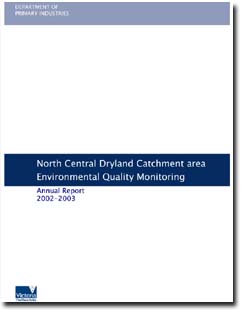Environmental Monitoring Annual Report 2002/03
- Environmental Monitoring Annual Report 2002/03 pdf docs
- Avon-Richards pdf docs
- Avoca pdf docs
- Loddon pdf docs
- Campaspe pdf docs
To view the information PDF requires the use of a PDF reader. This can be installed for free from the Adobe website (external link).
Environmental Quality monitoring is a component of the Victorian Statewide Salinity Monitoring Strategy, a document that provides guidelines for tracking the effectiveness of the Victorian Salinity Program and individual Salinity Management Plans. Environmental Quality monitoring involves the assessment of the condition of significant wetlands and remnant vegetation in a Plan’s area to determine if salinity levels and salinity mitigation works are improving, stabilising or degrading the current condition of the environment being monitored.
To meet the requirements of the Victorian Salinity Program, an Environmental Monitoring Program was developed and implemented for the Avoca, Avon-Richardson, Campaspe and Loddon Dryland Catchments in North Central Victoria between 1996-1997.
There are 17 remnant vegetation and five wetland sites being monitored across the four catchments that make up the North Central Catchment Management Authority (NCCMA) dryland area. These sites have depth to watertable monitored monthly and annual surveys of vegetation composition and vegetation health. Vegetation surveys include assessments of tree canopy health, amount of regeneration and photo points to illustrate any changes occurring within the vegetation quadrats. Wetlands have water quality and macroinvertebrate samples collected and analysed when applicable.
Monitoring sites were selected based on their location in high priority for salinity sub-catchments and are at immediate or future risk from salinity. Sites also contain vegetation types representative of those found prior to European settlement and are accessible at all times of the year (for bore monitoring). Some of these sites may have had salinity mitigation works occurring on nearby properties. Therefore monitoring is important to determine whether these works are having a positive impact on the dryland salinity problem.
 | Acknowledgements (PDF 136KB) | |
| Executive Summary (PDF 136KB) vroAvoca (PDF 136KB) vroAvon-Richardson (PDF 1.7MB) vroLoddon (PDF 136KB) vroCampaspe (PDF 136KB) | ||
1 | Introduction (PDF 622KB) | |
2 | Background (PDF 622KB) | |
3 | Catchment Description (PDF 622KB) | |
4 | Methodology (PDF 622KB) | |
5 | Results (PDF 622KB) vroAvoca (PDF 136KB) vroAvon-Richardson (PDF 1.7MB) vro Loddon (PDF 83KB) vroCampaspe (PDF 83KB) | |
6 | Identification of factors other than dryland salinity that will affect results (PDF 83KB) | |
7 | References (PDF 83KB) | |
Appendices | ||
| 8.1 Site and Quadrat Maps | Avoca, Avon-Richardson, Loddon, Campaspe (PDF 1.6MB) | |
| 8.2 Vegetation Survey Spreadsheets | Avoca, Avon-Richardson, Loddon, Campaspe (PDF 120KB) | |
| 8.3 Interpretation & Analysis of Results of Vegetation Surveys | Avoca, Avon-Richardson, Loddon, Campaspe (PDF 42KB) | |
| 8.4 Tree Health (PDF 837KB) | Avoca, Avon-Richardson, Loddon, Campaspe (PDF 64KB) | |
| 8.5 Groundwater Hydrographs | Avoca, Avon-Richardson, Loddon, Campaspe (PDF 121KB) | |
| 8.6 Water Quality | Avoca, Avon-Richardson, Loddon (PDF 59KB) | |
| 8.7 Macroinvertebrates (PDF 194KB) | Avoca, Avon-Richardson, Loddon (PDF 60KB) | |


